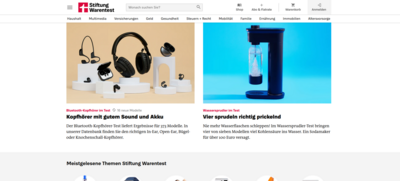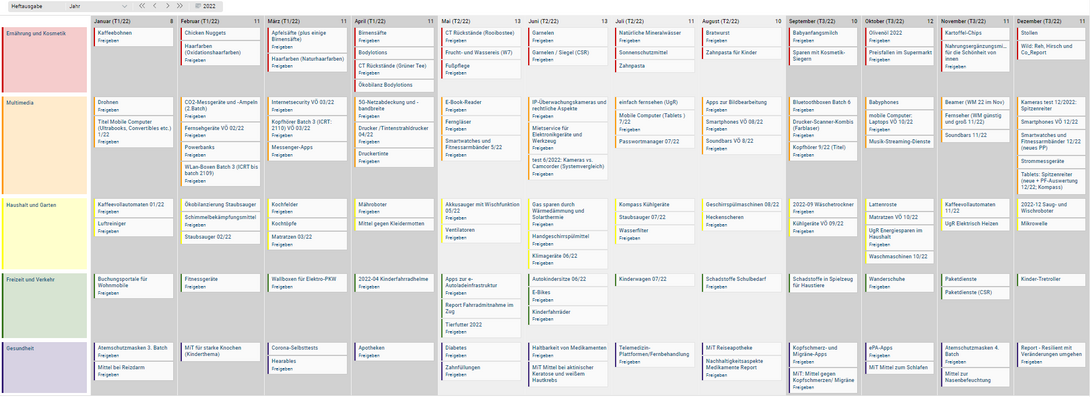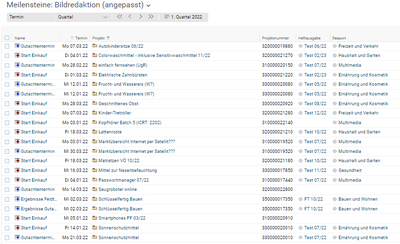BCS is our central information system
User report from Stiftung Warentest
Projektron BCS was able to score functionally, e.g. through the many customization options and the handling of project templates. A major factor in favor of BCS was the possibility of integrating the monthly topic plans into the system and thus being able to show almost everything in one tool.
Testing for consumer protection
In 1964, Stiftung Warentest was founded by the Federal Republic of Germany, represented by the Federal Minister of Economics, to promote consumer protection. According to its statutes, it is to "inform the public about objectifiable characteristics of the usefulness and utility value as well as the environmental compatibility of goods and private as well as individually usable public services."
Stiftung Warentest examines products, both goods and services, and publishes the results in its magazines (Finanztest, test) and on its website. In addition, special publications and books are produced. We test and evaluate more than 30,000 products in about 300 projects every year. A minimum of 3 months must be calculated for the test work, but 18 months' lead time may also be required. In different phases, processing steps of different processors have to be considered in the planning, both internally and externally.
Search for central information system
A planning tool had been in place for some time for part of the house, but this had become outdated and had to be replaced. Before individual projects can be organized, a plan is drawn up for each of the print publications and for online. In the so-called topic plan, it is determined which topic is to be published in which issue.
Various aspects have to be taken into account, e.g.:
- Is the topic seasonal (e.g., consumers on the topic of "lawn care" are more likely to seek help and information on the latest products in the spring than in the winter)?
- Are there new developments and how quickly can they be tested?
In the past, a lot of plans were made in Excel for these issue planning compilations. Therefore, publication schedules for print publications in particular should be mapped in an integrated way in the planning system, taking into account digital and online publications as well.
Some important goals were:
- to create a centralized information system in-house and to support the process to a large extent, from the clarification of topics, to the project management of investigations, to the publication of articles in our publications.
- support stakeholder self-direction, i.e., empower all project stakeholders as much as possible to participate independently in the planning system.
From a large number of vendors, three were shortlisted. After a briefing on our part, the selected vendors presented their products and showed proposed solutions for our requirements.
The system from Projektron was able to score points functionally, e.g. through the many customization options and the handling of project templates. At the same time, it did not reveal any essential weaknesses or risks. The system was preconfigured as part of a proof of concept (PoC) and presented in-house. A major factor in favor of Projektron's BCS was the demonstrated possibility of integrating the monthly topic plans into the system and thus being able to show almost everything in one tool.
The PoC was successful, so the system was further configured and customized and finally rolled out to all investigation teams in early 2020. Based on these diverse requirements, the choice fell on Projektron's Business Coordination Software. The main reasons were the good usability of the user interface and the numerous features that covered all of the required criteria.
BCS in use
Stiftung Warentest uses BCS Projektron in particular for the collection and evaluation of research ideas and project management for research projects as well as editorial projects. The idea management was adapted to the requirements of Stiftung Warentest and supplemented with options for describing topics. In preliminary discussions in the teams, selected ideas can then be transformed into project proposals. At the end, the joint topic planning is approved by the respective editor-in-chief. To do this, they use the option in the topic plan to "release" the projects and thus transfer them from the project proposals to the current projects.
To simplify the planning of the projects, the project templates are used. For different kinds of investigations there are given processes, which already contain generic sizes with rough efforts, which are then exchanged for acting persons. The effort is only partially adjusted. It is important for employees and supervisors that bottlenecks and overloads can be quickly identified and appropriate measures taken. Therefore, the exact resource management of BCS has no special importance in our company.
The developed project templates have already been adapted several times. Whereas in the previous planning tool, planning was done centrally by one person and only a few project participants adjusted the processing status directly in the system, now other project participants work with the system in addition to the project managers.
For most projects there is a project meeting. In this meeting, the project description (which is integrated in BCS) is discussed and subsequently approved with a workflow in BCS. The financial framework is also defined here. The most important information is transferred to SAP via an interface (the project number thus becomes a WBS element in SAP).
Very different milestone overviews have been created for the various project participants. For example, colleagues from purchasing can see in which timeframe products are to be purchased for which projects, or for the press office it can be displayed when and in which testing institute the tests will be carried out so that photos can be taken if necessary.
Outlook and conclusion
Stiftung Warentest will continue to adapt BCS to its requirements. In this context, new developments in the planning module are basically interesting, although especially the implementation of individual requirements by configuration has brought many improvements.
We have largely met our goals:
- All information about a project is stored in BCS.
- The link to Microsoft SharePoint helps to quickly access the files for the project.
- Everyone sees the same status of ideas, topics, projects and plans.
- Individual Word and Excel documents have been replaced.
- Processes and workflows have been replaced and simplified (e.g. approval workflows).
In this context, the integration with adjacent systems is also growing steadily, e.g. to our address database CRM based on Microsoft Dynamics.












